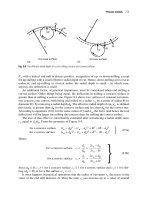Engineering Mechanics - Statics Episode 2 Part 5 ppsx
Bạn đang xem bản rút gọn của tài liệu. Xem và tải ngay bản đầy đủ của tài liệu tại đây (615.72 KB, 40 trang )
Engineering Mechanics - Statics Chapter 6
F
CD
M
2
ga b+()
2 sin
θ
()
a
= F
CD
6.5 kN=
Σ
F
x
= 0;
E
x
F
CD
cos
θ
()()
= E
x
5607N=
Σ
F
y
= 0;
E
y
M
2
g
2
− F
CD
sin
θ
()
+ 0=
E
y
M
2
g
2
F
CD
sin
θ
()
−= E
y
1766− N=
F
R
E
x
2
E
y
2
+= F
R
5.879 kN=
Problem 6-89
Determine the horizontal and vertical components of force at each pin. The suspended cylinder
has a weight W.
Given:
W 80 lb= d 6ft=
a 3ft= e 2ft=
b 4ft= r 1ft=
c 4ft=
Solution:
Guesses
A
x
1lb= B
x
1lb=
B
y
1lb= F
CD
1lb=
E
x
1lb= E
y
1lb=
Given
E
x
B
x
− W+ 0=
E
y
− B
y
+ 0=
561
© 2007 R. C. Hibbeler. Published by Pearson Education, Inc., Upper Saddle River, NJ. All rights reserved.
This material is protected under all copyright laws as they currently exist. No portion of this material may
be reproduced, in any form or by any means, without permission in writing from the publisher.
Engineering Mechanics - Statics Chapter 6
W− rE
y
a+ E
x
d− 0=
B
y
−
c
c
2
d
2
+
F
CD
+ W− 0=
B
y
− a
c
c
2
d
2
+
F
CD
d+ Wd e+ r−()− 0=
A
x
− B
x
+
d
c
2
d
2
+
F
CD
+ W− 0=
A
x
B
x
B
y
F
CD
E
x
E
y
⎛
⎜
⎜
⎜
⎜
⎜
⎜
⎜
⎜
⎝
⎞
⎟
⎟
⎟
⎟
⎟
⎟
⎟
⎟
⎠
Find A
x
B
x
, B
y
, F
CD
, E
x
, E
y
,
()
=
C
x
F
CD
d
c
2
d
2
+
= C
y
F
CD
c
c
2
d
2
+
= D
x
C
x
−= D
y
C
y
−=
A
x
B
x
B
y
C
x
C
y
D
x
D
y
E
x
E
y
⎛
⎜
⎜
⎜
⎜
⎜
⎜
⎜
⎜
⎜
⎜
⎜
⎜
⎜
⎝
⎞
⎟
⎟
⎟
⎟
⎟
⎟
⎟
⎟
⎟
⎟
⎟
⎟
⎟
⎠
160
80
26.667
160
106.667
160−
106.667−
8.694− 10
13−
×
26.667
⎛
⎜
⎜
⎜
⎜
⎜
⎜
⎜
⎜
⎜
⎜
⎜
⎝
⎞
⎟
⎟
⎟
⎟
⎟
⎟
⎟
⎟
⎟
⎟
⎟
⎠
lb=
562
© 2007 R. C. Hibbeler. Published by Pearson Education, Inc., Upper Saddle River, NJ. All rights reserved.
This material is protected under all copyright laws as they currently exist. No portion of this material may
be reproduced, in any form or by any means, without permission in writing from the publisher.
Engineering Mechanics - Statics Chapter 6
The two-member frame is pin connected at C, D, and E. The cable is attached to A, passes
over the smooth peg at B, and is attached to a load W. Determine the horizontal and vertical
reactions at each pin.
Given:
a 2ft=
b 1ft=
c 0.75 ft=
W 100 lb=
Solution:
d
c
b
a 2 b+()=
Initial guesses:
C
x
1lb= C
y
1lb= D
x
1lb= D
y
1lb= E
x
1lb= E
y
1lb=
Given
D
x
− C
x
+ W− 0=
D
y
− C
y
+ W− 0=
C
x
− cC
y
b+ Wd+ Wa 2 b+()− 0=
WC
x
− E
x
+ 0=
E
y
C
y
− 0=
W− dC
x
c+ C
y
b+ 0=
563
Problem 6-90
562
© 2007 R. C. Hibbeler. Published by Pearson Education, Inc., Upper Saddle River, NJ. All rights reserved.
This material is protected under all copyright laws as they currently exist. No portion of this material may
be reproduced, in any form or by any means, without permission in writing from the publisher.
Engineering Mechanics - Statics Chapter 6
C
x
C
y
D
x
D
y
E
x
E
y
⎛
⎜
⎜
⎜
⎜
⎜
⎜
⎜
⎜
⎝
⎞
⎟
⎟
⎟
⎟
⎟
⎟
⎟
⎟
⎠
Find C
x
C
y
, D
x
, D
y
, E
x
, E
y
,
()
=
C
x
C
y
D
x
D
y
E
x
E
y
⎛
⎜
⎜
⎜
⎜
⎜
⎜
⎜
⎜
⎝
⎞
⎟
⎟
⎟
⎟
⎟
⎟
⎟
⎟
⎠
133
200
33
100
33
200
⎛
⎜
⎜
⎜
⎜
⎜
⎜
⎜
⎝
⎞
⎟
⎟
⎟
⎟
⎟
⎟
⎟
⎠
lb=
Problem 6-91
Determine the horizontal and vertical components of force which the pins at A, B, and C exert
on member ABC of the frame.
Given:
F
1
400 N=
F
2
300 N=
F
3
300 N=
a 1.5 m=
b 2m=
c 1.5 m=
d 2.5 m=
f 1.5 m=
g 2m=
eab+ c+ d−=
Solution:
Guesses
A
y
1N= C
x
1N= C
y
1N=
F
BD
1N= F
BE
1N=
564
© 2007 R. C. Hibbeler. Published by Pearson Education, Inc., Upper Saddle River, NJ. All rights reserved.
This material is protected under all copyright laws as they currently exist. No portion of this material may
be reproduced, in any form or by any means, without permission in writing from the publisher.
Engineering Mechanics - Statics Chapter 6
Given
F
1
gF
2
ab+()+ F
3
a+ A
y
fg+()− 0=
F
1
gC
y
fg+()− 0=
C
x
e 0=
C
x
−
fg+
e
2
fg+()
2
+
F
BD
−
fg+
d
2
fg+()
2
+
F
BE
+ 0=
A
y
C
y
−
e
e
2
fg+()
2
+
F
BD
−
d
d
2
fg+()
2
+
F
BE
− 0=
A
y
C
x
C
y
F
BD
F
BE
⎛
⎜
⎜
⎜
⎜
⎜
⎜
⎜
⎝
⎞
⎟
⎟
⎟
⎟
⎟
⎟
⎟
⎠
Find A
y
C
x
, C
y
, F
BD
, F
BE
,
()
=
B
x
fg+
e
2
fg+()
2
+
− F
BD
fg+
d
2
fg+()
2
+
F
BE
+=
B
y
e
e
2
fg+()
2
+
F
BD
d
d
2
fg+()
2
+
F
BE
+=
A
y
657 N=
B
x
B
y
⎛
⎜
⎜
⎝
⎞
⎟
⎟
⎠
0
429
⎛
⎜
⎝
⎞
⎟
⎠
N=
C
x
C
y
⎛
⎜
⎜
⎝
⎞
⎟
⎟
⎠
0
229
⎛
⎜
⎝
⎞
⎟
⎠
N=
565
© 2007 R. C. Hibbeler. Published by Pearson Education, Inc., Upper Saddle River, NJ. All rights reserved.
This material is protected under all copyright laws as they currently exist. No portion of this material may
be reproduced, in any form or by any means, without permission in writing from the publisher.
Engineering Mechanics - Statics Chapter 6
The derrick is pin-connected to the pivot at A. Determine the largest mass that can be supported
by the derrick if the maximum force that can be sustained by the pin at A is F
max
.
Units Used:
kN 10
3
N=
g 9.81
m
s
2
=
Mg 10
3
kg=
Given:
F
max
18 kN=
L 5m=
θ
60 deg=
Solution:
AB is a two-force member.
Require
F
AB
F
max
=
+
↑
Σ
F
y
= 0;
F
AB
sin
θ
()
Mg
2
sin
θ
()
− W− 0=
M 2
F
AB
g
⎛
⎜
⎝
⎞
⎟
⎠
sin
θ
()
sin
θ
()
2+
⎛
⎜
⎝
⎞
⎟
⎠
= M 5.439
1
s
2
Mg=
Problem 6-93
Determine the required mass of the suspended cylinder if the tension in the chain wrapped
around the freely turning gear is T. Also, what is the magnitude of the resultant force on pin A?
Units Used:
kN 10
3
N=
g 9.8
m
s
2
=
566
Problem 6-92
© 2007 R. C. Hibbeler. Published by Pearson Education, Inc., Upper Saddle River, NJ. All rights reserved.
This material is protected under all copyright laws as they currently exist. No portion of this material may
be reproduced, in any form or by any means, without permission in writing from the publisher.
Engineering Mechanics - Statics Chapter 6
Given:
T 2kN=
L 2ft=
θ
30 deg=
φ
45 deg=
Solution:
Σ
M
A
= 0;
2− TLcos
θ
()
Mgcos
φ
()
Lcos
θ
()
+ Mgsin
φ
()
Lsin
θ
()
+ 0=
M
2 Tcos
θ
()
cos
φ
()
cos
θ
()
sin
φ
()
sin
θ
()
+
()
g
=
M 1793
1
s
2
kg=
+
→
Σ
F
x
= 0;
2 TMgcos
φ
()
− A
x
− 0=
A
x
2 TMgcos
φ
()
−=
+
↑
Σ
F
y
= 0;
Mgsin
φ
()
A
y
− 0=
A
y
Mgsin
φ
()
=
F
A
A
x
2
A
y
2
+=
F
A
2.928 kN=
567
© 2007 R. C. Hibbeler. Published by Pearson Education, Inc., Upper Saddle River, NJ. All rights reserved.
This material is protected under all copyright laws as they currently exist. No portion of this material may
be reproduced, in any form or by any means, without permission in writing from the publisher.
Engineering Mechanics - Statics Chapter 6
The tongs consist of two jaws pinned to links at A, B, C, and D. Determine the horizontal and
vertical components of force exerted on the stone of weight W at F and G in order to lift it.
Given:
a 1ft=
b 2ft=
c 1.5 ft=
d 1ft=
W 500 lb=
Solution:
Guesses
F
x
1lb=
F
y
1lb=
F
AD
1lb=
F
BE
1lb=
Given 2 F
y
W− 0= F
AD
bF
x
bc+()− 0=
F
AD
F
x
−
a
a
2
d
2
+
⎛
⎜
⎝
⎞
⎟
⎠
F
BE
− 0= F
y
−
d
a
2
d
2
+
⎛
⎜
⎝
⎞
⎟
⎠
F
BE
+ 0=
F
x
F
y
F
AD
F
BE
⎛
⎜
⎜
⎜
⎜
⎜
⎝
⎞
⎟
⎟
⎟
⎟
⎟
⎠
Find F
x
F
y
, F
AD
, F
BE
,
()
=
G
x
G
y
⎛
⎜
⎜
⎝
⎞
⎟
⎟
⎠
F
x
F
y
⎛
⎜
⎜
⎝
⎞
⎟
⎟
⎠
=
F
x
F
y
G
x
G
y
⎛
⎜
⎜
⎜
⎜
⎜
⎝
⎞
⎟
⎟
⎟
⎟
⎟
⎠
333
250
333
250
⎛
⎜
⎜
⎜
⎜
⎝
⎞
⎟
⎟
⎟
⎟
⎠
lb=
Problem 6-95
Determine the force
P
on the cable if the spring is compressed a distance
δ
when the mechanism
is in the position shown. The spring has a stiffness k.
568
Problem 6-94
© 2007 R. C. Hibbeler. Published by Pearson Education, Inc., Upper Saddle River, NJ. All rights reserved.
This material is protected under all copyright laws as they currently exist. No portion of this material may
be reproduced, in any form or by any means, without permission in writing from the publisher.
Engineering Mechanics - Statics Chapter 6
Given:
δ
0.5 in= c 6in=
k 800
lb
ft
= d 6in=
a 24 in= e 4in=
b 6in=
θ
30 deg=
Solution:
F
E
k
δ
= F
E
33.333 lb=
The initial guesses are
P 20 lb= B
x
11 lb=
B
y
34 lb= F
CD
34 lb=
Given
Σ
M
A
= 0;
B
x
bB
y
c+ F
E
ab+()− 0=
Σ
M
D
= 0;
B
y
dPe− 0=
+
→
Σ
F
x
= 0;
B
x
− F
CD
cos
θ
()
+ 0=
Σ
M
B
= 0;
F
CD
sin
θ
()
dPde+()− 0=
F
CD
B
x
B
y
P
⎛
⎜
⎜
⎜
⎜
⎜
⎝
⎞
⎟
⎟
⎟
⎟
⎟
⎠
Find F
CD
B
x
, B
y
, P,
()
=
B
x
135.398 lb= B
y
31.269 lb= F
CD
156.344 lb= P 46.903 lb=
569
© 2007 R. C. Hibbeler. Published by Pearson Education, Inc., Upper Saddle River, NJ. All rights reserved.
This material is protected under all copyright laws as they currently exist. No portion of this material may
be reproduced, in any form or by any means, without permission in writing from the publisher.
Engineering Mechanics - Statics Chapter 6
The scale consists of five pin-connected members. Determine the load W on the pan EG if a
weight F is suspended from the hook at A.
Given:
F 3lb= b 3in=
a 5in= c 4in=
d 6in= f 2in=
e 8in=
Solution:
Guesses T
C
10 lb= T
D
10 lb= T
G
10 lb= W 10 lb=
Given
Member ABCD:
Σ
M
B
= 0;
Fa T
C
b− T
D
be+ d−()− 0=
Member EG:
Σ
M
G
= 0;
T
C
− eWc+ 0=
Σ
F
y
= 0;
T
G
W− T
C
+ 0=
Member FH:
Σ
M
H
= 0;
T
D
− df+()T
G
f+ 0=
T
C
T
D
T
G
W
⎛
⎜
⎜
⎜
⎜
⎜
⎝
⎞
⎟
⎟
⎟
⎟
⎟
⎠
Find T
C
T
D
, T
G
, W,
()
=
W 7.06 lb=
Problem 6-97
The machine shown is used for formin
g
metal
p
lates. It consists of two to
gg
les
A
BC and
D
E
F
,
570
Problem 6-96
© 2007 R. C. Hibbeler. Published by Pearson Education, Inc., Upper Saddle River, NJ. All rights reserved.
This material is protected under all copyright laws as they currently exist. No portion of this material may
be reproduced, in any form or by any means, without permission in writing from the publisher.
Engineering Mechanics - Statics Chapter 6
gp gg
which are operated by the hydraulic cylinder H. The toggles push the movable bar G forward,
pressing the plate p into the cavity. If the force which the plate exerts on the head is P,
determine the force F in the hydraulic cylinder for the given angle
θ
.
Units Used:
kN 10
3
N=
Given:
P 12 kN=
a 200 mm=
θ
30 deg=
Solution:
Member EF:
Σ
M
E
= 0;
F
y
− acos
θ
()
P
2
asin
θ
()
+ 0=
F
y
P
2
tan
θ
()
= F
y
3.464 kN=
Σ
F
x
= 0;
E
x
P
2
− 0=
E
x
P
2
= E
x
6kN=
Σ
F
y
= 0;
E
y
F
y
− 0=
E
y
F
y
= E
y
3.464 kN=
Joint E:
Σ
F
x
= 0;
F
DE
− cos
θ
()
E
x
− 0=
F
DE
E
x
−
cos
θ
()
= F
DE
6.928− kN=
Σ
F
y
= 0;
FE
y
− F
DE
sin
θ
()
+ 0=
FE
y
F
DE
sin
θ
()
−= F 6.93 kN=
Problem 6-98
Determine the horizontal and vertical components of force at pins A and C of the two-member
frame.
571
© 2007 R. C. Hibbeler. Published by Pearson Education, Inc., Upper Saddle River, NJ. All rights reserved.
This material is protected under all copyright laws as they currently exist. No portion of this material may
be reproduced, in any form or by any means, without permission in writing from the publisher.
Engineering Mechanics - Statics Chapter 6
Given:
w
1
500
N
m
=
w
2
400
N
m
=
w
3
600
N
m
=
a 3m=
b 3m=
Solution:
Guesses
A
x
1N= A
y
1N= C
x
1N= C
y
1N=
Given
A
y
C
y
+
1
2
w
1
a− w
2
a− 0= A
x
a
1
2
w
1
a
2 a
3
−
1
2
w
3
b
b
3
− w
2
a
a
2
− 0=
A
x
− C
x
+
1
2
w
3
b+ 0= A
y
− a
1
2
w
1
a
a
3
+ 0=
A
x
A
y
C
x
C
y
⎛
⎜
⎜
⎜
⎜
⎜
⎝
⎞
⎟
⎟
⎟
⎟
⎟
⎠
Find A
x
A
y
, C
x
, C
y
,
()
=
A
x
A
y
C
x
C
y
⎛
⎜
⎜
⎜
⎜
⎜
⎝
⎞
⎟
⎟
⎟
⎟
⎟
⎠
1400
250
500
1700
⎛
⎜
⎜
⎜
⎜
⎝
⎞
⎟
⎟
⎟
⎟
⎠
N=
572
© 2007 R. C. Hibbeler. Published by Pearson Education, Inc., Upper Saddle River, NJ. All rights reserved.
This material is protected under all copyright laws as they currently exist. No portion of this material may
be reproduced, in any form or by any means, without permission in writing from the publisher.
Engineering Mechanics - Statics Chapter 6
Problem 6-99
The truck rests on the scale, which consists of a series of compound levers. If a mass M
1
is
placed on the pan P and it is required that the weight is located at a distance x to balance the
“beam” ABC, determine the mass of the truck. There are pins at all lettered points. Is it
necessary for the truck to be symmetrically placed on the scale? Explain.
Units Used:
Mg 10
3
kg= g 9.81
m
s
2
=
Given:
M
1
15 kg= FD 3m=
x 0.480 m= EF 0.2 m=
a 0.2 m=
HI 0.1 m= GH 2.5 m=
KJ HI= KG GH=
Solution:
Member ABC :
Σ
M
B
= 0;
M
1
− gx F
AD
a+ 0=
F
AD
M
1
g
x
a
= F
AD
72 s
2
N=
Member EFD :
Σ
M
E
= 0;
F
y
− EF F
AD
FD EF+()+ 0=
F
y
F
AD
FD EF+
EF
⎛
⎜
⎝
⎞
⎟
⎠
= F
y
1152 s
2
N=
573
© 2007 R. C. Hibbeler. Published by Pearson Education, Inc., Upper Saddle River, NJ. All rights reserved.
This material is protected under all copyright laws as they currently exist. No portion of this material may
be reproduced, in any form or by any means, without permission in writing from the publisher.
Engineering Mechanics - Statics Chapter 6
Member GHI :
Σ
M
I
= 0;
H
y
HI G
Y
GH HI+()− 0=
Member JKG :
F
y
G
y
−
()
KJ GH+()K
y
KJ()− 0=
Σ
M
J
= 0;
K
y
H
y
+ F
y
KJ KG+
HI
=
Scale Platform :
Σ
F
y
= 0;
K
y
H
y
+ W=
WF
y
KJ KG+
HI
⎛
⎜
⎝
⎞
⎟
⎠
=
M
W
g
= M 14.98 Mg=
Because KJ = HI and KG = GH it doesn't matter where the truck is on the scale.
Problem 6-100
By squeezing on the hand brake of the bicycle, the
rider subjects the brake cable to a tension
T
If the
caliper mechanism is pin-connected to the bicycle
frame at B, determine the normal force each brake
pad exerts on the rim of the wheel. Is this the
force that stops the wheel from turning? Explain.
Given:
T 50 lb=
a 2.5 in=
b 3in=
574
© 2007 R. C. Hibbeler. Published by Pearson Education, Inc., Upper Saddle River, NJ. All rights reserved.
This material is protected under all copyright laws as they currently exist. No portion of this material may
be reproduced, in any form or by any means, without permission in writing from the publisher.
Engineering Mechanics - Statics Chapter 6
Solution:
Σ
M
B
= 0;
N− bTa+ 0=
NT
a
b
= N 41.7 lb=
This normal force
does not
stop the wheel from turning. A frictional force (see Chapter 8),
which acts along the wheel's rim stops the wheel.
Problem 6-101
If a force of magnitude P is applied perpendicular to the handle of the mechanism, determine
the magnitude of force
F
for equilibrium. The members are pin-connected at A, B, C, and D.
Given:
P 6lb=
a 25 in=
b 4in=
c 5in=
d 4in=
e 5in=
f 5in=
g 30 in=
Solution:
Σ
M
A
= 0;
F
BC
bPa− 0=
F
BC
Pa
b
=
575
© 2007 R. C. Hibbeler. Published by Pearson Education, Inc., Upper Saddle River, NJ. All rights reserved.
This material is protected under all copyright laws as they currently exist. No portion of this material may
be reproduced, in any form or by any means, without permission in writing from the publisher.
Engineering Mechanics - Statics Chapter 6
F
BC
37.5 lb=
+
→
Σ
F
x
= 0;
A
x
− P+ 0=
A
x
P= A
x
6lb=
+
↑
Σ
F
y
= 0;
A
y
− F
BC
+ 0=
A
y
F
BC
= A
y
37.5 lb=
Σ
M
D
= 0;
e− A
x
A
y
bc+()− gb+ c+()F+ 0=
F
eA
x
A
y
bc+()+
gb+ c+
= F 9.423 lb=
Problem 6-102
The pillar crane is subjected to the load having a mass M. Determine the force developed in the
tie rod AB and the horizontal and vertical reactions at the pin support C when the boom is tied
in the position shown.
Units Used:
kN 10
3
N=
Given:
M 500 kg=
a 1.8 m=
b 2.4 m=
θ
1
10 deg=
θ
2
20 deg=
g 9.81
m
s
2
=
Solution:
initial guesses:
F
CB
10 kN= F
AB
10 kN=
576
© 2007 R. C. Hibbeler. Published by Pearson Education, Inc., Upper Saddle River, NJ. All rights reserved.
This material is protected under all copyright laws as they currently exist. No portion of this material may
be reproduced, in any form or by any means, without permission in writing from the publisher.
Engineering Mechanics - Statics Chapter 6
Given
M−
2
gcos
θ
1
()
F
AB
cos
θ
2
()
− F
CB
b
a
2
b
2
+
+ 0=
M−
2
gsin
θ
1
()
F
AB
sin
θ
2
()
− F
CB
a
a
2
b
2
+
+ Mg− 0=
F
AB
F
CB
⎛
⎜
⎜
⎝
⎞
⎟
⎟
⎠
Find F
AB
F
CB
,
()
=
C
x
C
y
⎛
⎜
⎜
⎝
⎞
⎟
⎟
⎠
F
CB
a
2
b
2
+
b
a
⎛
⎜
⎝
⎞
⎟
⎠
=
F
AB
C
x
C
y
⎛
⎜
⎜
⎜
⎝
⎞
⎟
⎟
⎟
⎠
9.7
11.53
8.65
⎛
⎜
⎜
⎝
⎞
⎟
⎟
⎠
kN=
Problem 6-103
The tower truss has a weight W and a center of gravity at G. The rope system is used to hoist it
into the vertical position. If rope CB is attached to the top of the shear leg AC and a second
rope CD is attached to the truss, determine the required tension in BC to hold the truss in the
position shown. The base of the truss and the shear leg bears against the stake at A, which can
be considered as a pin. Also, compute the compressive force acting along the shear leg.
Given:
W 575 lb=
θ
40 deg=
a 5ft=
b 3ft=
c 10 ft=
d 4ft=
e 8ft=
Solution: Entire system:
Σ
M
A
= 0;
T
BC
cos
θ
()
de+()T
BC
sin
θ
()
a− Wa b+()− 0=
T
BC
Wa b+()
cos
θ
()
de+( ) sin
θ
()
a−
=
T
BC
769lb=
577
© 2007 R. C. Hibbeler. Published by Pearson Education, Inc., Upper Saddle River, NJ. All rights reserved.
This material is protected under all copyright laws as they currently exist. No portion of this material may
be reproduced, in any form or by any means, without permission in writing from the publisher.
Engineering Mechanics - Statics Chapter 6
CA is a two-force member. At C:
φ
atan
e
bc+
⎛
⎜
⎝
⎞
⎟
⎠
=
initial guesses:
F
CA
500 lb= T
CD
300 lb=
Given
Σ
F
x
= 0;
F
CA
a
a
2
de+()
2
+
T
CD
cos
φ
()
+ T
BC
cos
θ
()
− 0=
Σ
F
y
= 0;
F
CA
de+
a
2
de+()
2
+
T
CD
sin
φ
()
− T
BC
sin
θ
()
− 0=
F
CA
T
CD
⎛
⎜
⎜
⎝
⎞
⎟
⎟
⎠
Find F
CA
T
CD
,
()
= T
CD
358lb= F
CA
739lb=
Problem 6-104
The constant moment M is applied to the crank shaft. Determine the compressive force P that is
exerted on the piston for equilibrium as a function of
θ
.
Plot the results of P (ordinate) versus
θ
(abscissa) for
0 deg
θ
≤ 90 deg≤
.
Given:
a 0.2 m=
b 0.45 m=
M 50 N m⋅=
Solution:
acos
θ
()
bsin
φ
()
=
φ
asin
a
b
cos
θ
()
⎛
⎜
⎝
⎞
⎟
⎠
=
M− F
BC
cos
θφ
−
()
a+ 0=
578
© 2007 R. C. Hibbeler. Published by Pearson Education, Inc., Upper Saddle River, NJ. All rights reserved.
This material is protected under all copyright laws as they currently exist. No portion of this material may
be reproduced, in any form or by any means, without permission in writing from the publisher.
Engineering Mechanics - Statics Chapter 6
F
BC
M
acos
θφ
−
()
=
PF
BC
cos
φ
()
=
M cos
φ
()
acos
θφ
−
()
=
This function goes to infinity at
θ
= 90 deg,
so we will only plot it to
θ
= 80 deg.
θ
0 0.1, 80 =
φθ
()
asin
a
b
cos
θ
deg
()
⎛
⎜
⎝
⎞
⎟
⎠
= P
θ
()
M cos
φθ
()()
acos
θ
deg
φθ
()
−
()
=
0 20406080
0
500
1000
1500
Degrees
Newtons
P
θ
()
θ
Problem 6-105
Five coins are stacked in the smooth plastic
container shown. If each coin has weight W,
determine the normal reactions of the bottom
coin on the container at points A and B.
Given:
W 0.0235 lb=
a 3=
b 4=
579
© 2007 R. C. Hibbeler. Published by Pearson Education, Inc., Upper Saddle River, NJ. All rights reserved.
This material is protected under all copyright laws as they currently exist. No portion of this material may
be reproduced, in any form or by any means, without permission in writing from the publisher.
Engineering Mechanics - Statics Chapter 6
Solution:
All coins :
Σ
F
y
= 0;
N
B
5W=
N
B
0.1175 lb=
Bottom coin :
Σ
F
y
= 0;
N
B
W− N
b
a
2
b
2
+
⎛
⎜
⎝
⎞
⎟
⎠
− 0=
NN
B
W−
()
a
2
b
2
+
b
⎛
⎜
⎝
⎞
⎟
⎠
=
N 0.1175 lb=
Σ
F
x
= 0;
N
A
N
a
a
2
b
2
+
⎛
⎜
⎝
⎞
⎟
⎠
=
N
A
0.0705 lb=
Problem 6-106
Determine the horizontal and vertical components of force at pin B and the normal force the pin
at C exerts on the smooth slot. Also, determine the moment and horizontal and vertical reactions
of force at A. There is a pulley at E.
Given:
F 50 lb=
a 4ft=
b 3ft=
Solution:
Guesses
B
x
1lb=
B
y
1lb=
N
C
1lb=
580
© 2007 R. C. Hibbeler. Published by Pearson Education, Inc., Upper Saddle River, NJ. All rights reserved.
This material is protected under all copyright laws as they currently exist. No portion of this material may
be reproduced, in any form or by any means, without permission in writing from the publisher.
Engineering Mechanics - Statics Chapter 6
A
x
1lb= A
y
1lb= M
A
1lbft⋅=
Given
B
x
a
a
2
b
2
+
⎛
⎜
⎝
⎞
⎟
⎠
N
C
+ F− 0=
B
y
b
a
2
b
2
+
⎛
⎜
⎝
⎞
⎟
⎠
N
C
− F− 0=
FB
x
+
()
aFB
y
+
()
b− 0=
F
a
a
2
b
2
+
⎛
⎜
⎝
⎞
⎟
⎠
N
C
− A
x
− 0=
b
a
2
b
2
+
⎛
⎜
⎝
⎞
⎟
⎠
N
C
A
y
− 0=
F− 2 a
a
a
2
b
2
+
⎛
⎜
⎝
⎞
⎟
⎠
N
C
a+ M
A
+ 0=
B
x
B
y
N
C
A
x
A
y
M
A
⎛
⎜
⎜
⎜
⎜
⎜
⎜
⎜
⎜
⎝
⎞
⎟
⎟
⎟
⎟
⎟
⎟
⎟
⎟
⎠
Find B
x
B
y
, N
C
, A
x
, A
y
, M
A
,
()
= N
C
20lb=
B
x
B
y
⎛
⎜
⎜
⎝
⎞
⎟
⎟
⎠
34
62
⎛
⎜
⎝
⎞
⎟
⎠
lb=
A
x
A
y
⎛
⎜
⎜
⎝
⎞
⎟
⎟
⎠
34
12
⎛
⎜
⎝
⎞
⎟
⎠
lb=
M
A
336lb ft⋅=
Problem 6-107
A force
F
is applied to the handles of the vise grip. Determine the compressive force developed
on the smooth bolt shank A at the jaws.
581
© 2007 R. C. Hibbeler. Published by Pearson Education, Inc., Upper Saddle River, NJ. All rights reserved.
This material is protected under all copyright laws as they currently exist. No portion of this material may
be reproduced, in any form or by any means, without permission in writing from the publisher.
Engineering Mechanics - Statics Chapter 6
Given:
F 5lb= b 1in=
a 1.5 in= c 3in=
d 0.75 in= e 1in=
θ
20 deg=
Solution:
From FBD (a)
Σ
M
E
= 0;
Fb c+()F
CD
de+
c
2
de+()
2
+
⎡
⎢
⎣
⎤
⎥
⎦
b− 0=
F
CD
Fb c+()
c
2
de+()
2
+
bd e+()
⎡
⎢
⎣
⎤
⎥
⎦
= F
CD
39.693 lb=
Σ
F
x
= 0;
E
x
F
CD
c
c
2
de+()
2
+
⎡
⎢
⎣
⎤
⎥
⎦
=
E
x
34.286 lb=
From FBD (b)
Σ
M
B
= 0;
N
A
sin
θ
()
dN
A
cos
θ
()
a+ E
x
de+()− 0=
N
A
E
x
de+
sin
θ
()
d cos
θ
()
a+
⎛
⎜
⎝
⎞
⎟
⎠
=
N
A
36.0 lb=
Problem 6-108
If a force of magnitude P is applied to the grip of the clamp, determine the compressive force
F that the wood block exerts on the clamp.
582
© 2007 R. C. Hibbeler. Published by Pearson Education, Inc., Upper Saddle River, NJ. All rights reserved.
This material is protected under all copyright laws as they currently exist. No portion of this material may
be reproduced, in any form or by any means, without permission in writing from the publisher.
Engineering Mechanics - Statics Chapter 6
Given:
P 10 lb=
a 2in=
b 2in=
c 0.5 in=
d 0.75 in=
e 1.5 in=
Solution:
Define
φ
atan
b
d
⎛
⎜
⎝
⎞
⎟
⎠
=
φ
69.444 deg=
From FBD (a),
Σ
M
B
= 0;
F
CD
cos
φ
()
cPab+ c+()− 0=
F
CD
Pa b+ c+()
cos
φ
()
c()
= F
CD
256.32 lb=
+
↑
Σ
F
y
= 0;
F
CD
sin
φ
()
B
y
− 0=
B
y
F
CD
sin
φ
()
= B
y
240lb=
From FBD (b),
Σ
M
A
= 0;
B
y
dFe− 0=
F
B
y
d
e
= F 120lb=
583
© 2007 R. C. Hibbeler. Published by Pearson Education, Inc., Upper Saddle River, NJ. All rights reserved.
This material is protected under all copyright laws as they currently exist. No portion of this material may
be reproduced, in any form or by any means, without permission in writing from the publisher.
Engineering Mechanics - Statics Chapter 6
Problem 6-109
The hoist supports the engine of
mass M. Determine the force in
member DB and in the hydraulic
cylinder H of member FB.
Units Used:
kN 10
3
N=
Given:
M 125 kg= d 1m=
a 1m= e 1m=
b 2m= f 2m=
c 2m= g 9.81
m
s
2
=
Solution:
Member GFE:
Σ
M
E
= 0;
F
FB
−
cd+
cd+()
2
be−()
2
+
⎡
⎢
⎣
⎤
⎥
⎦
bMgab+()+ 0=
F
FB
Mg
ab+
bc d+()
⎡
⎢
⎣
⎤
⎥
⎦
cd+()
2
be−()
2
+=
F
FB
1.94 kN=
Σ
F
x
= 0;
E
x
F
FB
be−
cd+()
2
be−()
2
+
⎡
⎢
⎣
⎤
⎥
⎦
− 0=
E
x
F
FB
be−
cd+()
2
be−()
2
+
⎡
⎢
⎣
⎤
⎥
⎦
=
Member EDC:
Σ
Μ
c
= 0;
E
x
cd+()F
DB
e
e
2
d
2
+
⎛
⎜
⎝
⎞
⎟
⎠
d− 0=
F
DB
E
x
cd+
ed
⎛
⎜
⎝
⎞
⎟
⎠
e
2
d
2
+= F
DB
2.601 kN=
584
© 2007 R. C. Hibbeler. Published by Pearson Education, Inc., Upper Saddle River, NJ. All rights reserved.
This material is protected under all copyright laws as they currently exist. No portion of this material may
be reproduced, in any form or by any means, without permission in writing from the publisher.
Engineering Mechanics - Statics Chapter 6
The flat-bed trailer has weight W
1
and center of gravity at G
T
. It is pin-connected to the cab at
D. The cab has a weight W
2
and center of gravity at G
C
. Determine the range of values x for the
position of the load L of weight W
3
so that no axle is subjected to a force greater than F
Max
. The
load has a center of gravity at G
L
.
Given:
W
1
7000 lb= a 4ft=
W
2
6000 lb= b 6ft=
W
3
2000 lb= c 3ft=
F
max
5500 lb= d 10 ft=
e 12 ft=
Solution:
Case 1: Assume
A
y
F
max
=
Guesses A
y
F
max
= B
y
F
max
= C
y
F
max
=
x 1ft= D
y
F
max
=
Given A
y
B
y
+ W
2
− D
y
− 0=
W
2
− aD
y
ab+()− B
y
ab+ c+()+ 0=
D
y
W
1
− W
3
− C
y
+ 0=
W
3
xW
1
e+ D
y
cd+ e+()− 0=
B
y
C
y
D
y
x
⎛
⎜
⎜
⎜
⎜
⎜
⎝
⎞
⎟
⎟
⎟
⎟
⎟
⎠
Find B
y
C
y
, D
y
, x,
()
=
A
y
B
y
C
y
⎛
⎜
⎜
⎜
⎝
⎞
⎟
⎟
⎟
⎠
5.5 10
3
×
6.333 10
3
×
3.167 10
3
×
⎛
⎜
⎜
⎜
⎜
⎝
⎞
⎟
⎟
⎟
⎟
⎠
lb= x
1
x= x
1
30.917 ft=
Since B
y
> F
max
then this solution is no good.
Case 2: Assume
B
y
F
max
=
Guesses A
y
F
max
= B
y
F
max
= C
y
F
max
=
585
Problem 6-110
© 2007 R. C. Hibbeler. Published by Pearson Education, Inc., Upper Saddle River, NJ. All rights reserved.
This material is protected under all copyright laws as they currently exist. No portion of this material may
be reproduced, in any form or by any means, without permission in writing from the publisher.









